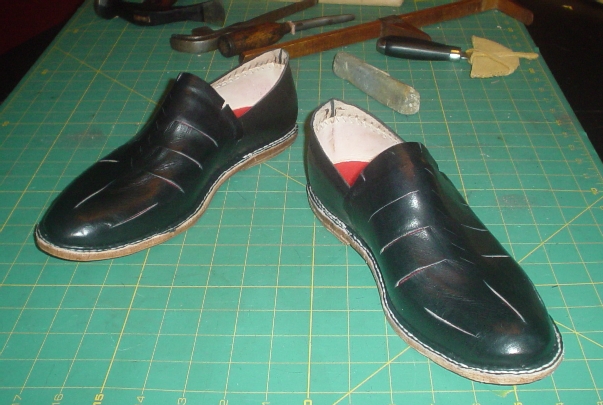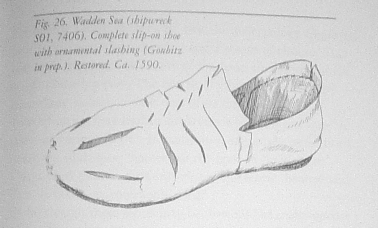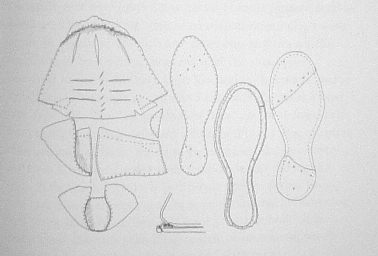I just finished up a new pair of shoes based on the Wadden Sea shipwreck finds. Specifically, Fig 26 on Page 227, although there were some differences between my attempt and the actual pattern. First, let me give you the cookie, and you can dig for more details deeper in the post.
Here is the pattern for the shoes.
A couple of things you will notice – reinforcements where the quarters meet the vamp, a leather lining for the quarters, heel and toe reinforcements (both of which are pegged), and slashes on the vamp. Interestingly enough, the vamp actually overlaps the quarters and is sewn in with tunnel stitches which make a hidden but secure seam.
I decided that I would only do a heel reinforcement, and that I would have it straight across rather than angled like the extant piece (for modern comfort. Also, you will note that the welt stitching is easily visible in my attempt, due to the style of last I have used. Most of my lasts are modern, simply because I do not have the inclination to carve new lasts for each client and make the shoes, and I have not yet attempted to curve the feather line on these modern lasts which would probably hide the welt stitching. Although some extant shoes do have an easily observed welt, many extant lasts and shoes from the 16th C. curve inward, essentially hiding the stitching from view.
I also whipped in a leather lining for the back and a reinforcement patch for the sides. You can see it over and whipped through the silk lining for the vamp. Although I have allowed this lining to show through the slashes in the vamp, we have limited documentation (i.e. I cannot find any as yet) for contrasting lining on slashed shoes – all of the images I have seen show the wearer’s hose through it, the hose often contrasting.

The heel is done in two layers of stitching, although the original was probably stitched all at the same time, as only one layer of stitching seems evident from Goubitz’ redrawings. However, two layers of stitching does give a nice visual appeal which will hopefully not be lost on the viewers!

All in all, I’m pleased with the attempt, and I may fool around with altering the last next time to draw the welt inwards more.



Great work and very inspiring! I found your site through your profile at the Crispin Colloquy forum. I haven’t read everything here yet but am interested to know more about your training as a shoemaker. I appreciate all the great information here and please keep it up.
Thanks for the comment! Please feel free to ask any questions – aside from a couple of workshops, I’m pretty much self-taught and researched, which is both good and bad, I think! =)
Thanks. I have learned a lot from reading your site. I look forward to seeing more.